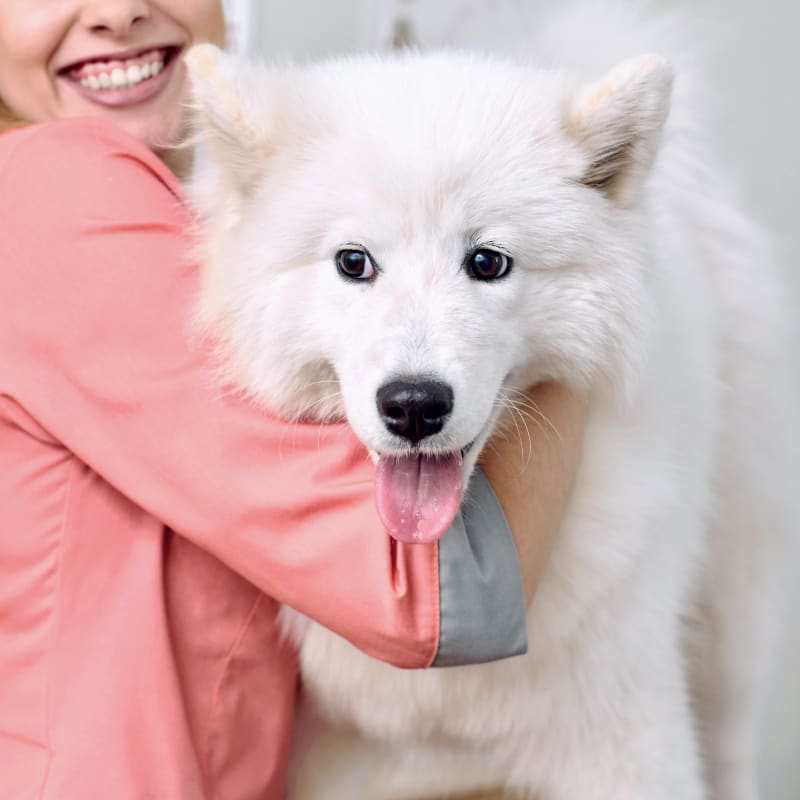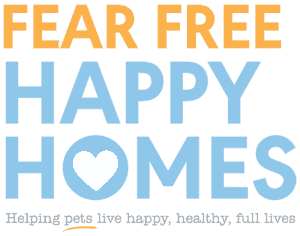Fear Free Certification
Our Team is Fear Free Certified
Every member of our team at Eagle Ridge Veterinary Hospital is Fear Free certified. We use the techniques gained from our certifications to try and reduce the stress, anxiety, and fear that is often associated with veterinary appointments.
Our hospital is also working towards Practice Certification, which requires a practice to meet 27 different mandatory standards as well as earn 1070 points out of a possible 2060 towards another 28 standards.

Our Fear Free Certification
Eagle Ridge Veterinary Hospital is dedicated to decreasing stress, anxiety, and fear in our patients while offering medical care.
There are both small and big changes in our hospital that have led to our staff being Fear Free Certified. Small changes include offering kongs, mats, treats and hiding spaces to our patients. It also includes allowing cats to stay in their carriers during treatment and dogs to sit on their owners' laps.
Larger changes have also been made, such as the design of the practice to include separate cat and dog areas.
Our staff have all worked hard, not only to become Fear Free Certified but in practicing Fear Free and low-stress techniques when working with all of our beloved patients.
How We Implement Fear Free
At our veterinary clinic, the Fear Free approach informs veterinary practices throughout the hospital and is prioritized second only to medical care.
We work with our patients and their people to undertake the following steps before and during each appointment.
- Good Communication Between Pets & People
We start by understanding and identifying how pets communicate signs of stress to us.
These signs can range from subtle to obvious: from tense expressions to dilated pupils, hissing, growling or a tucked tail.
We also discuss the pet's known stressors with the owner, which can include sounds, scents, discomfort, disease processes, and unfamiliar people.
Getting to know our feline and canine patients and their needs, including understanding their common stressors and how they communicate that, helps us to better manage their emotions during their visit.
We ask the family to speak up. If there is something that causes fear, stress or anxiety, (FAS) let us know.
- Planning Ahead
An anxiety-free veterinary appointment starts at home. Let us know if your pet gets stressed going to the vet. We can offer suggestions to do at home before the visit. There may be options to send supplements or medication home before the visit to help with car sickness or to help decrease the level of stress at the vet.
Let us know if your pet gets stressed by coming into the veterinary lobby as well as with new people or animals. We can let you wait in your car or outside of our waiting area and then come in directly to the examination room. We have multiple entrances to our hospital to help with this.
Let us know if your pet does better with male or female vets.
Cats and small to medium-sized dogs should be acclimated to their carriers. This can be accomplished by leaving the carrier out in an area of the home where the pet likes to be. Place a towel over the top of the carrier to help create a safe place with familiar scents.
The carrier should be outfitted with toys, soft, comfortable bedding or a non-slip mat, and should have a top-off option to make it more accessible.
You can also spray cat or dog pheromones, either in the carrier or onto a bandana for larger dogs.
If transporting a medium to large dog, be sure to use an approved restraint device in the car. The drive to the vet can be kept low stress by avoiding hard stops or starts and with calm music or silence.
Bring their favourite treats or toys to the visit.
- A Calm, Quiet Environment
At our veterinary office, we try to keep the atmosphere calm and quiet.
To help reduce your pet's anxiety in the waiting area, make sure that you keep your cat or dog separate from other animals as much as possible. Cat carriers should be kept elevated off of the floor on a sturdy table or chair. Keep your dog leashed and close to your side to minimize interaction with other waiting pets.
During the appointment, our veterinary team will remain calm, speak in quiet voices and approach the pet in a slow, careful manner, as dogs and cats are often sensitive to loud noises and quick movements.
- Treats & Toys
To try and decrease fear, stress, and anxiety during the visit, rewards such as treats, toys, or petting/brushing can be used during an exam or when obtaining diagnostics as long as it is not contraindicated based on why the pet is at the hospital.
We have treats throughout the hospital. If your cat or dog is on a special diet, we encourage you to bring their treats or food with you to the visit.
- Sedation & Restraint Options
Our staff is trained in low-stress handling techniques. We use treats, petting, and toys as distractions. Families are allowed to be with their pets during procedures (excluding sedation, anesthesia, x-rays, and while the hospital is closed). The staff will direct families on how they can play a part in their pet's treatment resulting in lower stress for your pet and keeping staff and family safe during the procedure.
In some cases, we will reschedule a procedure if the pet is stressed. This allows us to send home medications before performing the procedures.
If restraint is required during a procedure, our staff may use a towel wrap, a muzzle, or an Elizabethan collar to ensure the patient is safe and comfortable during the process. A mild sedative may be recommended to make sure that the procedure can be performed safely.
If you already know that your pet experiences anxiety or stress when visiting the vet, it may be beneficial for the veterinarian to provide you with a mild sedative to give to your pet at home prior to an appointment
- Fear Free Overnight Stays
Our veterinary team has guidelines in place to minimize stress during overnight stays.
We work to minimize smells and loud noises, and we place calming pheromone diffusers around the hospital.
We also sometimes use soft music or white noise machines to interfere with any sudden noises. Lights are kept low, and pets are given soft bedding and places to hide to make them more comfortable.
If we need to move your pet around in the hospital, for an exam, a procedure, or a walk outside, it is done slowly and calmly, avoiding interactions with other patients. Mild sedatives or anti-anxiety medications may be used in the hospital to reduce stress during the stay.

